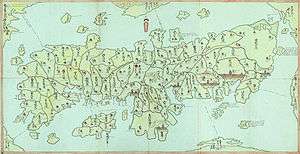Karatsu Domain

Karatsu Domain (唐津藩 Karatsu-han) was a Japanese domain of the Edo period. It is associated with Hizen Province in modern-day Saga Prefecture.[1]
In the han system, Karatsu was a political and economic abstraction based on periodic cadastral surveys and projected agricultural yields.[2] In other words, the domain was defined in terms of kokudaka, not land area.[3] This was different from the feudalism of the West.
History
Karatsu domain was founded in 1593, by Terazawa Hirotaka, who was granted lordship of Karatsu and landholdings of 83,000 koku. He was also Nagasaki bugyō under the Tokugawa bakufu. The Terazawa clan took part in the Battle of Sekigahara on the side of Tokugawa Ieyasu and received an additional 40,000 koku of land, bringing the total revenues of the domain up to 123,000 koku. The Terazawa took part in the Shogunate's expedition to suppress the Shimabara Uprising. The family held on to Karatsu until 1647, when Hirotaka's son Katataka committed suicide; due to a lack of heir, the family came to an end and the domain was confiscated by the central government.
Several families were rotated through Karatsu for the next century: two generations of the Ōkubo clan; three generations of the Ogyū-Matsudaira clan, four generations of the Doi clan, and four of the Mizuno clan, including the famous reformer Mizuno Tadakuni. The domain then passed into the hands of Ogasawara Nagamasa,[4] whose family remained until Karatsu domain was abolished in 1871. During the Boshin War of the Meiji Restoration of 1868-69, Ogasawara Nagamichi, the de facto ruler of Karatsu, led a group of his retainers on the side of the Ōuetsu Reppan Dōmei; after the fall of this alliance he went to Ezo and fought under the forces of the Ezo Republic. At the same time, Karatsu's domain-based administration was forced to pledge military support to the Satchō Alliance of Emperor Meiji.
Ogasawara Naganari, the Meiji period Imperial Japanese Navy admiral, was a descendant of the Ogasawara branch which ruled Karatsu.
List of daimyo
The hereditary daimyo were head of the clan and head of the domain.
Name Tenure Courtesy title Court Rank Revenue 1 Terazawa Hirotaka[5] (寺沢広高) 1593-1633 Shima-no-kami Lower 4th (従四位下) 83,000→ 123,000 koku 2 Terazawa Katataka[5] (寺沢堅高) 1633-1647 Hyogoto (兵庫頭) Lower 5th (従五位下) 123,000 koku
- Ōkubo clan 1649-1678 (fudai; 90,000 koku)[6]
Name Tenure Courtesy title Court Rank Revenue 1 Ōkubo Tadamoto (大久保忠職) 1649-1670 Kaga-no-kami Lower 4th (従四位下) 83,000 koku 2 Ōkubo Tadatomo (大久保忠朝) 1670-1678 Kaga-no-kami Lower 5th (従五位下) 83,000 koku
- Matsudaira (Ogyū) clan 1678-1691 (fudai; 70,000->60,000 koku)[7]
Name Tenure Courtesy title Court Rank Revenue 1 Matsudaira Norihisa (松平乗久) 1678-1686 Izumi-no-kami Lower 4th (従四位下) 70,000 koku 2 Matsudaira Noriharu (松平乗春) 1686-1690 Izumi-no-kami Lower 5th (従五位下) 70,000 koku 3 Matsudaira Norisato (松平乗邑) 1690-1691 Izumi-no-kami Lower 4th (従四位下) 60,000 koku
- Doi clan 1691-1762 (fudaiff; 70,000 koku)[8]
Name Tenure Courtesy title Court Rank Revenue 1 Doi Toshimasu (土井利益) 1691-1713 Suo-no-kami Lower 5th (従五位下) 70,000 koku 2 Doi Toshizane (土井利実) 1713-1736 Oito (大炊頭) Lower 5th (従五位下) 70,000 koku 3 Doi Toshinobu (土井利延) 1736-1744 Oito (大炊頭) Lower 5th (従五位下) 70,000 koku 4 Doi Toshisato (土井利里) 1744-1762 Oito (大炊頭) Lower 4th (従四位下) 70,000 koku
-
 Mizuno clan 1762-1817 (fudai; 60,000 koku)[9]
Mizuno clan 1762-1817 (fudai; 60,000 koku)[9]
Name Tenure Courtesy title Court Rank Revenue 1 Mizuno Tadatō (水野忠任) 1762-1775 Izumi-no-kami Lower 5th (従五位下) 60,000 koku 2 Mizuno Tadakane (水野忠鼎) 1775-1805 Ukonoefu (左近将監) Lower 5th (従五位下) 60,000 koku 3 Mizuno Tadaaki (水野忠光) 1805-1812 Izumi-no-kami Lower 5th (従五位下) 60,000 koku 4 Mizuno Tadakuni (水野忠邦) 1812-1817 Echizen-no-kami, Rōjū Lower 5th (従五位下) 60,000 koku
-
 Ogasawara clan 1817-1871 (Fudai; 60,000 koku)[10]
Ogasawara clan 1817-1871 (Fudai; 60,000 koku)[10]
Name Tenure Courtesy title Court Rank Revenue 1 Ogasawara Nagamasa (小笠原長昌) 1817-1823 Tomoro-no-tsukasa(主殿頭) Lower 5th (従五位下) 60,000 koku 2 Ogasawara Nagayasu (小笠原長泰) 1823-1833 Iki-no-kami Lower 5th (従五位下) 60,000 koku 3 Ogasawara Nagao (小笠原長会) 1833-1836 Noto-no-kami Lower 5th (従五位下) 60,000 koku 4 Ogasawara Nagakazu (小笠原長和) 1836-1840 Sado-no-kami Lower 5th (従五位下) 60,000 koku 5 Ogasawara Nagakuni (小笠原長国) 1840-1871 Nakatsukasa daiyū (中務大輔) Lower 5th (従五位下) 60,000 koku
See also
References

- ↑ "Hizen Province" at JapaneseCastleExplorer.com; retrieved 2013-5-28.
- ↑ Mass, Jeffrey P. and William B. Hauser. (1987). The Bakufu in Japanese History, p. 150.
- ↑ Elison, George and Bardwell L. Smith (1987). Warlords, Artists, & Commoners: Japan in the Sixteenth Century, p. 18.
- ↑ Rein, Japan, p. 521.
- 1 2 3 Papinot, Jacques Edmond Joseph. (1906). Dictionnaire d’histoire et de géographie du Japon; Papinot, (2003). "Terazawa" at Nobiliare du Japon, p. 60; retrieved 2013-5-29.
- ↑ Papinot, (2003). "Ōkubo" at Nobiliare du Japon, p. 46; retrieved 2013-5-29.
- ↑ Papinot, (2003). "Matsudaira (Ogyū)" at Nobiliare du Japon, p. 30; retrieved 2013-6-7.
- ↑ Papinot, (2003). "Doi" at Nobiliare du Japon, p. 5; retrieved 2013-6-7.
- ↑ Papinot, (2003). "Mizuno" at Nobiliare du Japon, p. 36; retrieved 2013-6-7.
- ↑ Bolitho, Treasures among Men, p. 258; Papinot, (2003). "Ogasawara" at Nobiliare du Japon, p. 45; retrieved 2013-6-7.
Further reading
- Bolitho, Harold. (1974). Treasures Among Men: The Fudai Daimyo in Tokugawa Japan. New Haven: Yale University Press. ISBN 978-0-300-01655-0; OCLC 185685588
- Rein, Johannes (1884). Japan: Travels and Researches Undertaken at the Cost of the Prussian Government. New York: A.C. Armstrong & Son.
External links
![]() Media related to Karatsu Castle at Wikimedia Commons
Media related to Karatsu Castle at Wikimedia Commons
- "Karatsu" at Edo 300 (Japanese)